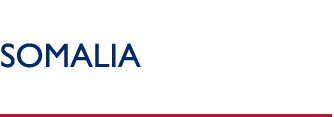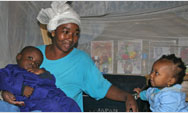 |
 |
|
 |
 |
|
 |
 |
|
 |
 |
 |
USAID Information:
External Links:
|
|
 |
 |
|
Somalia – Complex Emergency
December 10, 2008
Situation Report #3, Fiscal Year (FY) 2009 (PDF, 50kb)
Map (PDF, 281kb)
Background
Since 1991, widespread violence, endemic poverty, recurrent droughts, and floods have generated a complex emergency in Somalia. Continued civil strife and inter-clan conflicts have complicated the humanitarian situation and limited access to affected areas. In addition, ongoing fighting since late December 2006 between the Somalia Transitional Federal Government (TFG), Ethiopian forces, and armed militias opposed to the TFG has led to a further deterioration in humanitarian conditions. As a result, approximately 476,000 Somali refugees have fled the country and more than 1.1 million internally displaced persons (IDPs) are uprooted within Somalia, including long-term IDPs, as well as individuals displaced by increased fighting since February 2007.
In August 2008, the U.N. Food and Agriculture Organization (FAO) Food Security Analysis Unit (FSAU) reported that 3.2 million people are in need of humanitarian assistance in Somalia, representing 43 percent of the total population and a 77 percent increase since January 2008. Despite the onset of the September to December deyr rains, affected populations are expected to remain highly or extremely food insecure depending on location. The combined effects of consecutive seasons of failed or poor rainfall, continuing conflict, rising inflation, massive displacement, and diarrheal disease outbreaks have severely exacerbated the food security situation and resulted in a significant increase in acute malnutrition rates, according to the 2009 U.N. Consolidated Appeals Process (CAP) for Somalia. U.N. and partner agencies are coordinating efforts to improve access, but insecurity and targeted attacks against relief staff hinder the provision of emergency assistance to affected populations.
On October 31, 2008, U.S. Ambassador to Kenya Michael E. Ranneberger redeclared a disaster in Somalia due to the complex emergency. In FY 2008 and to date in FY 2009, the U.S. Government (USG) has provided nearly $354 million for emergency food assistance, health, nutrition, livelihoods support, protection, humanitarian coordination and information management, agriculture and food security, and water, sanitation, and hygiene programs, as well as refugee assistance and air operations.
NUMBERS AT A GLANCE
| Total Population in Need of Emergency Assistance |
3.2 million |
FSAU – Aug. 2008 |
| Urban Caseload |
705,000 |
FSAU – Aug. 2008 |
| IDPs since February 2007 |
870,000 |
FSAU – Aug. 2008 |
| Long-Term IDPs |
275,000 |
FSAU – Aug. 2008 |
| Rural Caseload |
1,395,000 |
FSAU – Aug. 2008 |
| Somali Refugees in Djibouti, Kenya, Ethiopia, and Yemen |
334,000 |
UNHCR(1) Global Trends Report – June 2008 |
|
FY 2008 HUMANITARIAN FUNDING
| USAID/OFDA Humanitarian Assistance to Somalia: |
$55,179,365 |
| USAID/FFP (2) Humanitarian Assistance to Somalia: |
$276,915,600 |
| State/PRM (3) Humanitarian Assistance to Somalia: |
$21,850,000 |
| Total USAID and State Humanitarian Assistance to Somalia: |
$353,944,965 |
|
|
|
|
Current Situation
Despite the onset of seasonal rains and associated improvements in pasture and crop production, the collective impact of increased food and fuel prices, ongoing drought conditions in some areas, and widespread insecurity continues to contribute to
deteriorating humanitarian conditions in Somalia. According to the USAID-supported Famine Early Warning Systems Network (FEWS NET), 3.2 million people, or 43 percent of the total population, are in need of emergency humanitarian assistance,
representing a 77 percent increase since January 2008. In addition, targeted attacks against humanitarian staff, the impact of piracy on food aid delivery, and renewed fighting in Mogadishu continue to hinder humanitarian access and the provision of relief commodities to affected populations.
On December 1, the U.N. officially launched the 2009 U.N. CAP for Somalia requesting $918 million to address the needs of more then 3.2 million Somalis requiring humanitarian assistance. The increased funding request from $662 million in 2008 to $918 million in 2009 reflects increased humanitarian needs, as well as escalating commodity and transport costs resulting from the global food crisis and general insecurity. The U.N. CAP identifies nine priority sectors, including agriculture and livelihoods, education, food aid, health, logistics, nutrition, protection, shelter, and water, sanitation, and hygiene.
Security and Population Movements
Deteriorating civil insecurity and the targeting of humanitarian staff have resulted in reduced humanitarian access and new population displacement in Somalia. According to the U.N., 152 security related incidents directed at humanitarian aid workers occurred between January 1 and October 27, resulting in 33 deaths to date.
Following five coordinated car bombs detonated in the self-declared Republic of Somaliland in northwestern Somalia and the semi-autonomous State of Puntland in northeastern Somalia on October 29, USAID/FFP-implementing partner WFP temporarily suspended food distributions in northern Somalia. As of November 20, WFP had resumed work in affected areas. However, WFP anticipates insecurity will continue to impede distribution efforts.
According to UNHCR, violence has displaced approximately 250,000 people from Mogadishu since January, including more than 110,000 newly displaced people since September 1. In addition, at least 476,000 Somali refugees are currently residing in Djibouti, Kenya, Ethiopia, and Yemen.
In November, FEWS NET reported that officials had registered more than 44,000 Somalis in Dadaab refugee camps in the North Eastern Province of Kenya since January 2008. Since September, an average of 5,000 refugees have arrived per month. The Dadaab refugee camps, originally designed to accommodate 90,000 refugees, now host more than 225,000 people. Negotiations continue between UNHCR and the Government of Kenya to secure land for the construction of additional camps to meet expanded refugee population needs.
In FY 2008 and to date in FY 2009, State/PRM has provided a total of $32.5 million for programs targeting Somalia refugees in Kenya, Ethiopia, Djibouti, and Yemen.
Nutrition
According to the U.N. Children’s Fund (UNICEF), malnutrition rates in Somalia are among the highest in the world, including an estimated 300,000 acutely malnourished children, representing one in six children under the age of five.
However, malnutrition rates continue to increase in areas of Somalia. According to recent FSAU and partner nutrition surveys conducted from November 13 to November 21, global acute malnutrition rates (GAM) exceed 20 percent in coastal areas of Galbeed and Awdal regions, significantly above the emergency threshold of 15 percent. In addition, severe acute malnutrition (SAM) rates have significantly increased since May, from approximately 3.5 to nearly 6 percent, above the emergency SAM threshold of 1 percent.
Results from a November 21 FSAU report indicate an increasing prevalence of poor consumption patterns among urban populations, further contributing to malnutrition concerns. FAO assessments in Bay, Bakool, Bari, Nugal, Sanaag, and Sool regions identified an insufficiently diversified diet among 40 to 67 percent of assessed households.
In response to increased malnutrition concerns, USAID/OFDA implementing partner UNICEF is supporting two supplementary feeding centers, five outpatient therapeutic centers, and two stabilization centers in Mogadishu that treat an average of 1,400 moderately malnourished and 1,800 severely malnourished children monthly. In addition, UNICEF is providing protein and vitamin enriched food supplements to approximately 10,000 children under the age of five residing in northern Mogadishu IDP camps per month.
In FY 2008 and to date in FY 2009, USAID/OFDA has provided nearly $10.9 million for nutrition activities in Somalia, including more than $4.1 million to UNICEF. In addition, USAID/OFDA has committed $2.5 million to FSAU’s nutrition unit for nutrition monitoring activities throughout Somalia.
Emergency Food Assistance
Piracy off the coast of Somalia continues to impede commercial transport, underscoring the need for naval escorts to ensure the delivery of the approximately 90 percent of emergency food assistance transported by sea. In November, the International Maritime
Organization reported more than 120 attacks since
January 1, including more than 35 ship seizures.
On October 23, the Government of the Netherlands dispatched a naval escort for U.N. World Food Program (WFP) contracted vessels transporting food aid to Somalia. Between November 23 and 27, NATO and Dutch naval frigates successfully escorted 18,730 metric tons (MT) of WFP food shipments to Marka and Mogadishu. On December 8, the European Union (EU) deployed six warships and three surveillance aircraft to the Horn of Africa to replace the Dutch vessel for the next 12 months. The deployment represents the first-ever EU naval mission and is comprised of vessels from at least eight member countries.
In December, WFP plans to distribute 27,630 MT of food to beneficiaries throughout Somalia. However, WFP currently confronts an overall shortfall of 14,734 MT of food aid commodities through March 2009, according to the U.N.
In FY 2008, USAID/OFDA committed more than $20 million for the regional purchase of 26,107 MT of maize to support WFP food aid operations, targeting an estimated 2 million beneficiaries.
In FY 2008 and to date in FY 2009, USAID/FFP has provided more than 290,000 MT of P.L. 480 Title II emergency food assistance, valued at more than $276 million. In total, USAID/FFP assistance aims to support approximately 3 million Somalis countrywide.
Food Security
According to FEWS NET, the food security situation remains critical for urban poor, displaced, and pastoralist populations. Food prices, though stabilizing, remain at record high levels and many households have exhausted existing coping mechanisms. In the most likely scenario, food insecurity will remain high through March 2009, particularly in south and central Somalia, according to FEWS NET.
An October FSAU urban assessment indicated a significant gap between income and ability to cover minimum needs among urban poor, particularly in Sanaag, Bari, and Galgadud regions. Staple food costs in Dhuusamarreeb, Galgadud Region, increased 88 percent between March and October, according to FSAU.
In addition, drought has resulted in low livestock birth rates and elevated morbidity, significantly diminishing livestock herds, according to FAO. Furthermore, pastoralists have sold large numbers of animals during the last 6 to 12 months to cover high food costs, negatively affecting livelihoods and resulting in increased numbers of pastoralists dependent on food aid.
In FY 2008 and to date in FY 2009, USAID/OFDA has committed more than $3.5 million to FAO for food security monitoring projects, including support for FSAU assessment programs.
Water, Sanitation, and Hygiene
Poor water, sanitation, and hygiene conditions persist throughout Somalia, contributing to increased incidences of waterborne diseases. According to UNICEF, more than 70 percent of Somalis lack reliable access to safe drinking water.
Between August 13 and October 31, the U.N. World Health Organization (WHO) reported 532 cases of acute watery diarrhea (AWD), including 8 deaths in Marka, Lower Shabelle Region. Between January 1 and November 7, preliminary WHO data indicated an increased AWD caseload in Galgadud Region, including 2,105 cases resulting in 26 deaths. In addition, FSAU reported a total of 300 AWD cases in Bossasso, Bari Region, between September 6 and October 31, including 8 deaths. FSAU noted that children under five years of age accounted for 51 percent of all admissions in Bassasso. Inadequate case management and referral delays to cholera treatment centers have elevated case fatality rates, according to recent WHO assessments.
Nearly $9 million in FY 2008 USAID/OFDA funding supports water, sanitation, and hygiene interventions countrywide, including Mercy USA programs targeting more than 260,000 beneficiaries in Middle Juba, Middle Shabelle, Hiraan, and Galgadud regions.
For detailed information on U.S. Government humanitarian assistance to Somalia, please see Situation Report #3, Fiscal Year (FY) 2009 (PDF, 50kb)
Back to Top ^
|


